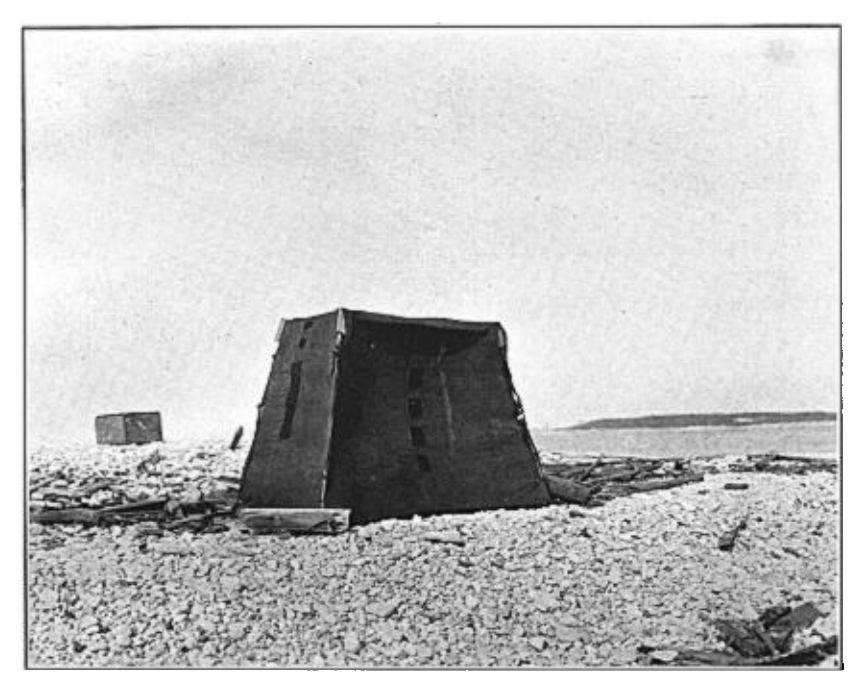The scenic drama of the Niagara Escarpment, the limestone spine ridging Door County, can hardly be overstated. We got to admire it today from land and from water alike, first with a “trolley” ride through Peninsula State Park and then, on a cool and breezy afternoon, from the deck of a boat that took us out towards the Sister Islands and their white haze of ring-billed and herring gulls.
Exactly 100 years ago today, on June 26, 1914, R.M. Strong paid his own first visit to the Sisters as part of his study of the herring gulls breeding in Door County.
Over the course of that summer, Strong visited colonies on several of the county’s islands, making detailed records of their behavior and breeding from a cramped blind “made from dark green cambric lining cloth, costing seven cents a yard.”
 From here, Strong was able to watch the birds pairing, building, incubating, brooding, feeding, and, of course, fighting. Our trip this afternoon confirmed that at least that last component of larid behavior persists.
From here, Strong was able to watch the birds pairing, building, incubating, brooding, feeding, and, of course, fighting. Our trip this afternoon confirmed that at least that last component of larid behavior persists.
Strong’s work in Green Bay ranked him among the authorities of his day on gull behavior. In 1917, a few months after the entry of the United States into the war, he turned his expertise to the investigation of another, more immediately practical problem:
I read in ‘Science’ the recommendation of the Committee on Zoology of the National Research Council that the problem of “utilization of gulls and other aquatic seabirds in locating submarines be studied.”
Strong’s experience had taught him that it would useless to try to train gulls captured as adults, so he secured a small corps of chicks of flighted juveniles to work with. His preliminary results were encouraging: the young birds quickly grew tolerant of their human keepers, and herring gulls, he found, could recognize new situations in their environment — the hope was, of course, that they could be taught to recognize submarines and somehow “alert” their human monitors to the threatening presence.
Strong’s scheme proposed capturing large numbers of unfledged gulls, raising them, and keeping them on board navy ships until “regions of danger” had been reached. Once released, he predicted, the gulls would make short feeding flights from their “home” ship, when
by careful watching … variations in their movements would at least suggest that an unusual object was in the water.
The plan — of which Strong admitted “that the chances of success were limited, to say the least” — was never carried out. While Strong and his colleagues were working out the details, other, “very efficient methods for detection of submarines were developed,” and the “raid” on the gulls’ nesting colonies was never carried out.
The herring gulls of Lake Michigan could go back to their loafing and squabbling, activities they continue to excel in today.
Strong never tells us what else he saw out in the gulleries of Wisconsin and Michigan. So here’s our day list from a hundred years later:
Canada goose
mallard
American white pelican
double-crested cormorant
great egret
turkey vulture
osprey
bald eagle
sharp-shinned hawk
red-tailed hawk
killdeer
ring-billed gull
herring gull
Caspian tern
rock pigeon
mourning dove
chimney swift
northern flicker
red-eyed vireo
American crow
common raven
blue jay
purple martin
tree swallow
northern rough-winged swallow
cliff swallow
barn swallow
black-capped chickadee
house wren
American robin
European starling
cedar waxwing
yellow warbler
American redstart
chipping sparrow
song sparrow
northern cardinal
red-winged blackbird
common grackle
brown-headed cowbird
American goldfinch
house sparrow



